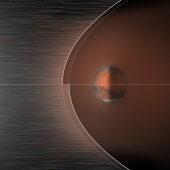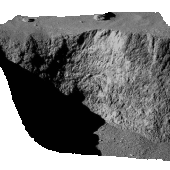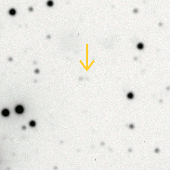ESA Science & Technology - Science Results
Science Results
Science Results
As the energetic particles of the solar wind speed across interplanetary space, their motion is modified by objects in their path. A study, based on data from ESA's Mars Express orbiter, has thrown new light on a surprising interaction between the planet Mars and supersonic particles in the solar wind.
Published: 22 August 2017
Scientists using the ESA/NASA SOHO solar observatory have found long-sought gravity modes of seismic vibration that imply the Sun's core is rotating four times faster than its surface.
Published: 1 August 2017
The international Cassini-Huygens mission has made a surprising detection of a molecule that is instrumental in the production of complex organics within the hazy atmosphere of Saturn's moon Titan.
Published: 26 July 2017
With the help of software that mimics a human brain, ESA's Gaia satellite spotted six stars zipping at high speed from the centre of our Galaxy to its outskirts. This could provide key information about some of the most obscure regions of the Milky Way.
Published: 26 June 2017
The challenging detection, by ESA's Rosetta mission, of several isotopes of the noble gas xenon at Comet 67P/Churyumov-Gerasimenko has established the first quantitative link between comets and the atmosphere of Earth.
Published: 8 June 2017
The NASA/ESA Hubble Telescope has peered across six billion light years of space to resolve extremely faint features of the galaxy cluster Abell 370 that have not been seen before. Imaged here in stunning detail, Abell 370 is part of the Frontier Fields programme which uses massive galaxy clusters to study the mysteries of dark matter and the...
Published: 4 May 2017
A Swedish-led team of astronomers used the NASA/ESA Hubble Space Telescope to analyse the multiple images of a gravitationally lensed type Ia supernova for the first time. The four images of the exploding star will be used to measure the expansion of the Universe.
Published: 20 April 2017
ESA's Cluster mission is challenging the current view of magnetic reconnection – the breaking and immediate rearrangement of magnetic field lines in the collision of two plasma flows.
Published: 10 April 2017
Rosetta's pioneering mission to explore a comet in unprecedented detail completed operations last year. As the science continues, members of the public, as well as scientists, can freely access hundreds of papers that reveal the comet's secrets. A special issue of Monthly Notices of the Royal Astronomical Society is the latest journal to provide...
Published: 4 April 2017
Astronomers have used the NASA/ESA Hubble Space Telescope to observe the remnant of a supernova explosion in the Large Magellanic Cloud. Beyond just delivering a beautiful image, Hubble may well have traced the surviving remains of the exploded star's companion.
Published: 30 March 2017
An international team of astronomers using the NASA/ESA Hubble Space Telescope have uncovered a supermassive black hole that has been propelled out of the centre of the distant galaxy 3C 186. The black hole was most likely ejected by the power of gravitational waves.
Published: 23 March 2017
Growing fractures, collapsing cliffs, rolling boulders and moving material burying some features on the comet's surface while exhuming others are among the remarkable changes documented during Rosetta's mission.
Published: 21 March 2017
Rosetta scientists have made the first compelling link between an outburst of dust and gas and the collapse of a prominent cliff, which also exposed the pristine, icy interior of the comet.
Published: 21 March 2017
ESA and NASA space telescopes have made the most detailed observation of an ultra-fast wind flowing from the vicinity of a black hole at nearly a quarter of the speed of light.
Published: 1 March 2017
ESA's XMM-Newton has found a pulsar – the spinning remains of a once-massive star – that is a thousand times brighter than previously thought possible.
Published: 21 February 2017
Scientists using the NASA/ESA Hubble Space Telescope have observed, for the first time, a massive, comet-like object that has been ripped apart and scattered in the atmosphere of a white dwarf. The destroyed object had a chemical composition similar to Halley's Comet, but was 100 000 times more massive than its famous counterpart.
Published: 9 February 2017
Scientists observing a curious neutron star in a binary system known as the 'Rapid Burster' may have solved a forty-year-old mystery surrounding its puzzling X-ray bursts.
Published: 31 January 2017
By using galaxies as giant gravitational lenses, an international group of astronomers using the NASA/ESA Hubble Space Telescope have made an independent measurement of how fast the Universe is expanding.
Published: 26 January 2017
Whilst best known for its surveys of the stars and mapping the Milky Way in three dimensions, ESA's Gaia has many more strings to its bow. Among them, its contribution to our understanding of the asteroids that litter the Solar System. Now, for the first time, Gaia is not only providing information crucial to understanding known asteroids, it...
Published: 24 January 2017
On 30 September 2016, at 11:19:37 UTC in ESA's mission control, Rosetta's signal flat-lined, confirming that the spacecraft had completed its incredible mission on the surface of Comet 67P/Churyumov-Gerasimenko some 40 minutes earlier and 720 million km from Earth.
Published: 15 December 2016
—
20 Items per Page




















